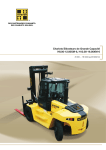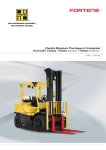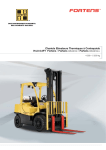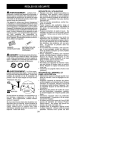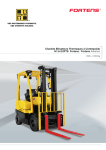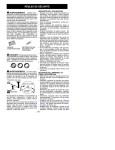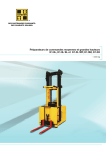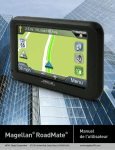Download Magellan ToughCase Downloadable Instruction Book
Transcript
Magellan® ToughCaseTM Instruction Booklet • Rugged and Waterproof to IPX-7 standards. • Internal Battery charges your iPhone® or iPod touch®. • Built-in GPS receiver enhances the GPS reception for your iPhone and enables the iPod touch to use applications that require GPS signals. Made for: iPhone 3GS, iPhone 3G, iPod touch (3rd generation), and iPod touch (2nd generation) Specifications: Waterproof: GPS: Antenna: Battery: Connectivity: IPX-7 SiRFStar III Multidirectional Patch Integrated, non-replaceable Mini-USB Headphone Headphones USB Connector Lift the flap to reveal the 3.5mm headphone connector. Note: headphones with an inline microphone, the Lift the flap to reveal the USB connector used to charge the ToughCase GPS receiver or sync your iPhone or iPod touch with iTunes. Mode Battery Level Volume Control Locking Flap Lift the locking flap on both sides to open the ToughCase GPS receiver. Top button increases volume, lower button decreases volume. Speaker Microphone Locking Flap The speaker and microphone openings provide access to the speaker and microphone of the installed iPhone. Lift the locking flap on both sides to open the ToughCase GPS receiver. Installing Your iPhone or iPod touch Lift the locking flaps on both sides of the ToughCase GPS receiver and pivot the lid upwards. The Master Power switch (upper left side) is accessible when the lid is open. Switch it to ON. Connect your iPhone to the dock connector. If using an iPod touch, you need to place your iPod touch into the Sleeve (supplied) and then connect the assembly to the dock connector. Close the lid and hold the lid shut while snapping the locking flaps until you hear a ‘click’. Turning the ToughCase GPS Receiver Off The ToughCase GPS receiver can be turned off to prevent unnecessary battery drain while being stored or during travel. Release the Locking Flaps and open the ToughCase GPS receiver. Remove your iPhone or iPod touch from the ToughCase GPS receiver. This reveals the Master Power switch. Slide it to OFF to keep battery charge. Setting the ToughCase Power Mode The ToughCase GPS receiver has four power modes available; OFF/ON (described above), idle, battery only, or battery+GPS. Pressing the Mode button (on the bottom of the ToughCase GPS receiver) causes the LEDs to display the current mode the ToughCase GPS receiver is in. To change the mode you need to press the Mode switch again before the LEDs go out. (When powering on, all lights flash momentarily.) Mode - LED Indicators Battery Only Battery and GPS Powering Down 471 El Camino Real Santa Clara, CA 95050 Charging the ToughCase GPS Receiver To charge the ToughCase GPS receiver, simply connect the USB cable from the ToughCase to your IBM-compatible or Macintosh computer. Alternatively, you can charge the ToughCase GPS Receiver with an AC adapter with a USB connector (like the one supplied with your iPhone) or purchase the AC Power Adapter from MagellanGPS.com. Note: When the battery in the ToughCase GPS receiver is below 5% charged, there is not enough power in the ToughCase to even power the red battery charge LED. This LED will remain off even after connecting to a PC or an AC adapter until the ToughCase internal battery is above 5% charge. ToughCase Battery Life When your iPhone or iPod touch is installed in the ToughCase GPS receiver and the power mode is set to Battery only or Battery+GPS, the battery in the ToughCase GPS receiver will charge your iPhone or iPod touch. The ToughCase GPS receiver charges when it is connected to a PC with the USB cable (supplied) or a USB power adapter. The ToughCase GPS receiver and your iPhone or your iPod touch are both charged when Master Power switch is on, a USB cable or USB power adapter is connected and the power mode is set to Battery Only or Battery+GPS. ToughCase Battery Status. The four LEDs at the bottom of the ToughCase GPS receiver display the battery charge when the battery button (below the LEDs) is pressed. Using the ToughCase with Your iPhone The ToughCase GPS receiver has an earphone opening just above the display lens and a microphone opening at the bottom. To use your iPhone as a cell phone while it is installed in the ToughCase GPS receiver, just hold the top of the ToughCase GPS receiver to your ear and speak normally. Some headsets and headphones have an inline microphone. These can be used with the ToughCase GPS receiver to listen to the output of your iPhone or iPod touch but cannot be used as the microphone. You have to use the microphone opening at the bottom of the ToughCase GPS receiver. Battery Charge - LED Indicators <10% Charge 10 - 24% Charge 25 - 49% Charge 50 - 74% Charge 75 - 100% Charge Turning your iPhone or iPod touch On The power buttons for your iPhone or iPod touch are located at the top of the ToughCase GPS receiver in their normal orientation. To power your iPhone, click the button on the right or click the button on the left to power your iPod touch. Camera Use You can use your iPhone to take photos while installed in the ToughCase GPS receiver. There is a clear lens on the back of the ToughCase GPS receiver that enables your iPhone camera to function as normal. Maintenance Use a soft, damp cloth to clean the exterior and display lens of the ToughCase GPS receiver. Check the seal on the lid of the ToughCase GPS receiver before closing to make sure no foreign objects are caught in the seal that could interfere with the waterproof integrity of the ToughCase GPS receiver. Check the o-ring that seals the lid to the body of the ToughCase GPS receiver at regular intervals. If it is damaged go to Support at www.magellangps.com. Safety The ToughCase GPS receiver protects your iPhone or iPod touch from water as it is sealed to IPX-7 standards. The temperature inside the ToughCase GPS receiver can go up to levels that can cause your iPhone or iPod touch to turn off when it is left in direct sunlight for long periods of time. You should avoid leaving the ToughCase GPS receiver in environments that could raise the internal temperature to unsafe levels such as on the dash or seat of your car where direct sunlight could raise the internal temperature. “Made for iPod,” and “Made for iPhone,” mean that an electronic accessory has been designed to connect specifically to iPod or iPhone respectively and has bee certified by the developer to meet Apple performance standards. Apple is not responsible for the operation of this device or its compliance with safety and regulatory standards. © 2010 MiTAC International Corporation. The Magellan logo and Magellan are registered trademarks of MiTAC International Corporation. ToughCase is a trademark of MiTAC International Corporation. All rights reserved. iPhone and iPod touch are trademarks of Apple, Inc., registered in the U.S. and other countries. All other trademarks and registered trademarks are property of their respective owners. 112-0009-001 A Livret d’Instruction Magellan® ToughCaseTM • Robuste et étanche aux normes IPX-7. • La batterie interne charge votre iPhone® ou iPod touch®. • Le récepteur GPS intégré améliore la réception GPS pour l’iPhone et permet à l’iPod touch d’utiliser des applications qui exigents des signaux GPS. Fait pour : iPhone 3GS, iPhone 3G, iPod touch (3rd generation), and iPod touch (2nd generation) Caractéristiques : Etanche : GPS : Antenne : Batterie : Connectivité : IPX-7 SiRFStar III Patch Multidirectionel Intégré, non-remplacable Mini-USB Ecouteurs Connecteur USB Ecouteurs Relevez le rabat pour révéler le connecteur d’écouteurs de 3,5 mm. Remarque : écouteurs avec un microphone en ligne, le microphone ne fonctionnera pas. Relevez le rabat pour révéler le connecteur USB utilisé pour recharger l’enveloppe ToughCase ou pour synchroniser l’iPhone/ iPod touch avec iTunes. Niveau de Batterie Mode Contrôle du volume Rabat de Verrouillage de Boîtier Soulevez le rabat de verrouillage des deux côtés pour ouvrir l’enveloppe ToughCase. Haut-parleur Microphone Rabat de Verrouillage de Boîtier Soulevez le rabat de verrouillage des deux côtés pour ouvrir l’enveloppe ToughCase. Les ouvertures de haut-parleur et de microphone donnent accès au haut-parleur ou au microphone de l’appareil installé. Installation de l’iPhone/iPod touch Soulevez le rabat de verrouillage de boîtier des deux côtés du boîtier et faites pivoter le couvercle vers le haut. L’interrupteur d’alimentation principal (en haut à gauche) est accessible lorsque le couvercle est ouvert. Faites le commuter sur On (Allumé). Connectez l’iPhone au connecteur à 30 broches. Si vous utilisez un iPod touch, vous devez placer l’iPod Touch dans l’iPod Sleeve (Enveloppe iPod) (fournie), puis connectez l’iPod/l’ensemble enveloppe au connecteur à 30 broches. Fermez le couvercle et enclenchez les rabats de verrouillage de boîtier jusqu’à ce que vous entendiez un “clic”. Eteindre l’enveloppe ToughCase L’enveloppe ToughCase peut être désactivée pour éviter de vider la batterie inutilement tout en étant stocké ou pendant un voyage. Relâchez les Rabats de Verrouillage de Boîtier et ouvrez l’enveloppe ToughCase. Enlevez l’iPhone/iPod touch à partir de l’enveloppe ToughCase. Cela révèle l’interrupteur d’alimentation principal. Faites-le glisser sur Off (Eteint) pour empêcher la batterie de se vider. Réglage du mode d’alimentation ToughCase L’enveloppe ToughCase dispose de quatre modes de puissance disponibles; ON/OFF (allumé/éteint) (décrit ci-dessus), au ralenti, batterie seule, ou batterie+GPS. En appuyant sur le commutateur Mode (en bas de l’enveloppe ToughCase) cela cause à la DEL d’afficher le mode actuel dans lequel l’enveloppe ToughCase est. Pour changer le mode, vous devez appuyer sur le commutateur Mode à nouveau avant que les voyants ne s’éteignent. Mode – Indicateurs DEL Batterie Seule Batterie et GPS Eteindre Autonomie de la Batterie ToughCase Quand un iPhone ou iPod touch est installé dans l’enveloppe ToughCase et que le mode d’alimentation est réglé à Batterie seule ou Batterie+GPS, la batterie dans l’enveloppe ToughCase chargera l’iPhone ou l’iPod touch. L’enveloppe ToughCase se charge quand elle est connectée à un PC avec le câble USB (fourni) ou un adaptateur secteur USB. L’enveloppe ToughCase et l’iPhone/iPod touch sont tous deux rechargés lorsque le commutateur d’alimentation principal est allumé, qu’un câble USB ou un adaptateur secteur USB est connecté et que le mode d’alimentation est réglé à Batterie Seule ou Batterie+GPS. Statut de Batterie ToughCase. Les quatre DEL au bas de l’enveloppe ToughCase affichent la charge de la batterie lorsque le bouton de la batterie (en dessous de la DEL) est appuyé. Utilisation de ToughCase avec l’iPhone d’Apple L’enveloppe ToughCase a une ouverture d’oreillette juste au-dessus de la lentille d’affichage et une ouverture microphone en bas. Pour utiliser votre iPhone comme un téléphone cellulaire alors qu’il est installé dans l’enveloppe ToughCase, il suffit de tenir le haut de l’enveloppe à votre oreille et de parler normalement. Certains casques et écouteurs ont un microphone en ligne. Ils peuvent être utilisés avec l’enveloppe ToughCase pour écouter la sortie de l’iPhone/iPod touch, mais ne peuvent pas être utiliss comme microphone. Vous devez utiliser l’ouverture du microphone en bas de l’enveloppe ToughCase. Allumer l’iPhone/iPod touch Charge de Batterie – Indicateurs DEL <10% de Charge 10 - 24% de Charge 25 - 49% de Charge 50 - 74% de Charge 75 - 100% de Charge Les boutons d’alimentation de l’iPhone et de l’iPod touch sont situés en haut de l’enveloppe ToughCase dans l’orientation normale. Le bouton d’alimentation iPhone est sur la droite et le bouton d’alimentation de l’iPod touch est sur la gauche. Utilisation de la Caméra Vous pouvez utiliser votre iPhone pour prendre des photos une fois installé dans l’enveloppe ToughCase. Il y a une lentille claire au dos de l’enveloppe ToughCase qui permet à l’appareil photo de l’iPhone de fonctionner normalement. Entretien Utilisez un chiffon doux et humide pour nettoyer l’extérieur et la lentille d’affichage de l’enveloppe ToughCase. Vérifiez le joint sur le couvercle de l’enveloppe ToughCase avant de fermer le couvercle pour vous assurer qu’aucun objet étranger n’est coincé dans le joint qui pourrait nuire à l’étanchéité de l’enveloppe ToughCase. Sécurité L’enveloppe ToughCase protège votre iPhone/iPod touch de l’eau car il est scellé aux normes IPX-7. De ce fait, la température à l’intérieur de l’enveloppe ToughCase peut aller jusqu’à des niveaux qui peuvent causer à l’iPhone/iPod touch de s’éteindre quand il est laissé en plein soleil pendant de longues périodes de temps. Vous devriez éviter de laisser l’enveloppe ToughCase sur le tableau de bord ou le siège de votre voiture où de la lumière du soleil directe pourrait augmenter la température interne. Magellan® ToughCaseTM Folleto de instrucciones • Robusto y resistente al agua según los estándares IPX-7. • La batería interna carga su iPhone® o iPod touch®. • El receptor GPS incorporado mejora la recepción GPS del iPhone y permite que el iPod touch use aplicaciones que requieren señales de GPS. Hecho para: iPhone 3GS, iPhone 3G, iPod touch (3rd generation), and iPod touch (2nd generation) Especificaciones: Resistente al agua: GPS: Antena: Batería: Conectividad: IPX-7 SiRFStar III Receptor multidireccional Integrada, no reemplazable Mini USB Auricular Auriculares Conector USB Levante la solapa para dejar ver el conector de auriculares de 3,5 mm. Nota: en los auriculares con micrófono incorporado, el micrófono no funcionará. Levante la solapa para dejar ver el conector USB utilizado para cargar la funda ToughCase o sincronizar el iPhone/ iPod touch con iTunes. Nivel de batería Modo Control de volumen Solapa de traba de la caja Levante la solapa de traba a ambos lados para abrir la funda ToughCase. Altavoz Micrófono Las aberturas para altavoz y micrófono permiten acceder al altavoz y al micrófono del dispositivo instalado. Solapa de traba de la caja Levante la solapa de traba a ambos lados para abrir la funda ToughCase. Cómo instalar el iPhone/iPod touch Levante las solapas de traba de la caja a ambos lados de la caja y gire la tapa hacia arriba. Se puede acceder al interruptor de alimentación maestra (lado superior izquierdo) cuando la tapa está abierta. Colóquelo en la posición de encendido. Conecte el iPhone al conector de 30 pines. Si está utilizando un iPod touch, debe colocarlo en la funda para iPod (suministrada) y luego conectar el conjunto iPod/funda al conector de 30 pines. Cierre la tapa y encaje las solapas de traba de la caja hasta que oiga un ‘clic’. Cómo apagar la funda ToughCase La funda ToughCase puede apagarse para evitar un consumo innecesario de la batería mientras está almacenada o durante los viajes. Suelte las solapas de traba de la caja y abra la funda ToughCase. Retire el iPhone/iPod touch de la funda ToughCase. Esto dejará ver el interruptor de alimentación maestra. Deslícelo a la posición de apagado para evitar el consumo de la batería. Cómo configurar el modo de alimentación de la ToughCase La casa ToughCase tiene cuatro modos de alimentación disponibles; apagado/encendido (descrito arriba), espera, batería únicamente o batería+GPS. Al presionar el interruptor de modo (en la parte inferior de la funda ToughCase), los LED muestran el modo actual en que se encuentra la ToughCase. Para cambiar el modo, debe presionar de nuevo el interruptor de modo antes de que se apaguen los LED. Modo – Indicadores LED Batería únicamente Batería y GPS Descargándose Vida útil de la batería de la ToughCase Cuando se instala un iPhone o iPod touch en la funda ToughCase y el modo de alimentación se configura en Batería únicamente o Batería+GPS, la batería de la funda ToughCase cargará el iPhone o iPod touch. La funda ToughCase se carga cuando está conectada a una PC con el cable USB (suministrado) o un adaptador de alimentación USB. La funda ToughCase y el iPhone/iPod touch se cargan cuando el interruptor de alimentación maestra está en la posición de encendido, cuando hay un cable USB o adaptador de alimentación USB conectado y cuando el modo de alimentación se configura en Batería únicamente o Batería+GPS. Estado de la batería de la ToughCase. Los cuatro LED de la parte inferior de la funda ToughCase muestran la carga de la batería cuando se presiona el botón de la batería (debajo de los LED). Cómo usar la ToughCase con el Apple iPhone La funda ToughCase tiene una abertura para auriculares arriba de la lente del visor y una abertura para micrófono en la parte inferior. Para usar su iPhone como teléfono celular mientras está instalado en la funda ToughCase, coloque la parte superior de la funda ToughCase junto a su oreja y hable con normalidad. Algunos auriculares tienen un micrófono incorporado. Éstos pueden usarse con la funda ToughCase para escuchar la salida del iPhone/iPod touch pero no puede utilizarse como micrófono. Tiene que usar la abertura para micrófono en la parte inferior de la funda ToughCase. Carga de la batería – Indicadores LED <Carga del 10% Carga del 10 24% Carga del 25 49% Carga del 50 74% Carga del 75 100% Cómo encender el iPhone/iPod touch Los botones de encendido del iPhone y el iPod touch se encuentran en la parte superior de la funda ToughCase, en la orientación normal. El botón de encendido del iPhone está a la derecha y el botón de encendido del iPod touch está a la izquierda. Uso de la cámara Puede utilizar su iPhone para tomar fotografías mientras está instalado en la funda ToughCase. En la parte trasera de la ToughCase, hay una lente transparente que permite que la cámara del iPhone funcione normalmente. Mantenimiento Use un trapo suave y húmedo para limpiar el exterior y la lente del visor de la funda ToughCase. Antes de cerrar la tapa, verifique que en la junta hermética de la tapa de la funda ToughCase no haya objetos extraños que puedan interferir con la integridad resistente al agua de la funda ToughCase. Seguridad La funda ToughCase protege su iPhone/iPod touch del agua, al estar sellada según los estándares IPX-7. Por este motivo, la temperatura interior de la funda ToughCase puede ascender a niveles que pueden provocar que el iPhone/iPod se apague cuando se deja a la luz solar directa durante periodos prolongados. Se debe evitar dejar la funda ToughCase en el tablero o el asiento de su automóvil cuando la luz solar directa pueda aumentar la temperatura interna.
This document in other languages
- français: Magellan ToughCase
- español: Magellan ToughCase







